HTML
--> --> -->In the conventional homogeneous diffusion model, the positrons are usually regarded as the secondary CRs, and their propagated energy spectrum is expected to be a featureless single power-law. The discovery of positron excess with respect to the conventional model hints the existence of extra primary components and has attracted significant attention. Numerous models have been proposed to explain this phenomenon, which could be attributed to either astrophysical phenomena, such as local pulsars [12, 13] and the hadronic interactions inside supernova remnants (SNRs) [14, 15], or more exotic origins like the dark matter self-annihilation or decay [16, 17]. Furthermore, the
Because of severe energy losses, the typical propagation distance of energetic electrons/positrons is significantly shorter compared with the low-energy ones. Thus, most of them arise from the sources within a few kpc. In this case, both the propagation process and source distribution is expected to have a considerable impact on the electron and positron spectra. In recent years, the SDP model has drawn increasing attention. It was originally introduced by [24] to account for the spectral hardening of CR proton and helium above 200 GV. Another possible interpretation of such remarkable spectral features can be attributed to the corresponding break in the injection spectrum of CRs [25, 26]. In contrast to the homogeneous diffusion, the entire diffusive region is split into two zones characterized by different diffusion properties in the SDP scenario. The Galactic disk and its surrounding areas within a few hundred parsecs are refered to as the inner halo (IH), and the extended regions outside of IH are referred to as the outer halo (OH) [24, 27-29]. In the vicinity of IH, the diffusion process is significantly slower than around OH. Recent observations of the radial gamma-ray profile of Geminga and PSR B0656+14 pulsars by the HAWC experiment indicate that the diffusion around these sources is inhibited by about two orders of magnitude decrease than the values inferred by fitting B/C ratio [30-32]. This provides a support to the SDP scenario.
However, a comprehensive study of the SDP model for both electron and positron spectra is still unavailable. The prediction of the SDP model on the electrons and positrons has been preliminarily investigated by [27, 33]. The expected positron flux fails to explain the AMS-02 measurements. As for the electron, above ~ 200 GeV, the theoretical flux starts to be lower than the observed flux, despite that the spectra at low energy can be reproduced. In particular, recently the AMS-02 collaboration published their updated observations of electrons and positrons, which affirmed the excess of electron flux above ~ 30 GeV found by [5, 6]. This feature has not been well studied in the past years. Meanwhile, in the previous studies, the CR sources are regarded as axisymmetrically distributed by default. The effect of the spiral distribution was investigated until the recent years [34-36]; however, it has not been studied in the SDP model. In this work, we investigate the influences of the propagation effect and source distribution on both electron and positron spectra, and thus different theoretical propagation models are compared in detail: homogeneous diffusion with axisymmetric distribution, SDP with axisymmetric distribution, and SDP with spiral distribution. We find that in the homogeneous diffusion with the axisymmetric distribution model, the electron and positron spectra are difficult to consider simultaneously even when introducing a local pulsar. This is due to the excess electron flux. With the specific transport parameters, the SDP model could prominently enhance the background electron and positron fluxes. Therefore, compared with the homogeneous diffusion, the SDP model could better describe the electron and positron spectra. The all-electron spectrum could also be well explained under the SDP with a spiral distribution model up to 20 TeV. The spectral break above TeV energies is a superposition of the contributions of background components and the local source. The anisotropies of electrons are computed, which shows that the expected anisotropy in the SDP model is far below the current observational limit, even when a local source is taken into account.
The rest of the paper is organized as follows. In Sec. 2, both the spatial-dependent propagation model and spiral distribution of sources are introduced in detail. Sec. 3 presents the calculated results, and Sec. 4 presents the conclusion.
2.1.Spatial-dependent propagation
After entering interstellar space, CRs undergo random walks within the Galactic magnetic field by bouncing off magnetic waves and magnetohydrodynamic turbulence. This process is typically described by a diffusion equation. The diffusive region, which is called magnetic halo, is approximated as a flat cylinder with its radius $\begin{split}\frac{{\partial \psi ({{r}},p,t)}}{{\partial t}} =& \nabla \cdot ({D_{xx}}\nabla \psi - {V_c}\psi ) + \frac{\partial }{{\partial p}}\left[ {{p^2}{D_{pp}}\frac{\partial }{{\partial p}}\frac{\psi }{{{p^2}}}} \right]\\ &- \frac{\partial }{{\partial p}}\left[ {\dot p\psi - \frac{p}{3}(\nabla \cdot {V_c}\psi )} \right] - \frac{\psi }{{{\tau _f}}} - \frac{\psi }{{{\tau _r}}} + q({{r}},p,t)\;,\end{split}$  | (1) |
${D_{xx}}({\cal R}) = {D_0}\beta {\left( {\frac{{\cal R}}{{{{\cal R}_0}}}} \right)^\delta }\;.$  | (2) |
${D_{xx}}(r,z,{\cal R}) = {D_0}F(r,z)\beta {\left( {\frac{{\cal R}}{{{{\cal R}_0}}}} \right)^{\delta (r,z)}}\;.$  | (3) |
$F(r,z) = \left\{ {\begin{array}{*{20}{l}}{g(r,z) + \left[ {1 - g(r,z)} \right]{{\left( {\dfrac{z}{{\xi {z_h}}}} \right)}^n},}&{|z| \leqslant \xi {z_h}}\\{1,}&{|z| > \xi {z_h}}\end{array},} \right.$  | (4) |
$\delta (r,z) = \left\{ {\begin{array}{*{20}{l}}{g(r,z) + \left[ {{\delta _0} - g(r,z)} \right]{{\left( {\dfrac{z}{{\xi {z_h}}}} \right)}^n},}&{|z| \leqslant \xi {z_h}}\\{{\delta _0},}&{|z| > \xi {z_h}}\end{array},} \right.$  | (5) |
${D_{pp}}{D_{xx}} = \frac{{4{p^2}v_{\rm A}^2}}{{3\delta (4 - {\delta ^2})(4 - \delta )}}\;,$  | (6) |
${q^{\rm{p}}}({\cal R}) = q_0^{\rm{p}}\left\{ {\begin{array}{*{20}{l}}{{{\left( {\dfrac{{\cal R}}{{{\cal R}_{{\rm{br}}}^{\rm{p}}}}} \right)}^{\nu _1^{\rm{p}}}},}&{{\cal R} \leqslant {\cal R}_{{\rm{br}}}^{\rm{p}}}\\{{{\left( {\dfrac{{\cal R}}{{{\cal R}_{{\rm{br}}}^{\rm{p}}}}} \right)}^{\nu _2^{\rm{p}}}}\exp \left[ { - \dfrac{{\cal R}}{{{\cal R}_{\rm{c}}^{\rm{p}}}}} \right],}&{{\cal R} > {\cal R}_{{\rm{br}}}^{\rm{p}}}\end{array}} \right. ,$  | (7) |
${q^{{{{e}}^ - }}}({\cal R}) = q_0^{{{{e}}^ - }}\left\{ {\begin{array}{*{20}{l}}{{{\left( {\dfrac{{\cal R}}{{{\cal R}_{{\rm{br}}}^{{{{e}}^ - }}}}} \right)}^{\nu _1^{{{{e}}^ - }}}},}&{{\cal R} \leqslant {\cal R}_{{\rm{br}}}^{{{{e}}^ - }}}\\{{{\left( {\dfrac{{\cal R}}{{{\cal R}_{{\rm{br}}}^{{{{e}}^ - }}}}} \right)}^{\nu _2^{{{{e}}^ - }}}},}&{{\cal R} > {\cal R}_{{\rm{br}}}^{{{{e}}^ - }}}\end{array}} \right. , $  | (8) |
Other species, e.g., Li, Be, B, and e+, are hardly synthesized during the stellar nucleosynthesis. They are generally considered to bring forth from the fragmentation of parent nuclei throughout the transport. They are usually defined as secondaries. For the production of Li, Be, and B, the so-called straight-ahead approximation [37] is adopted, where the kinetic energy per nucleon is conserved during the spallation process. The production rate is thus
${Q_j} = \sum\limits_{i = {\rm{C}},{\rm{N}},{\rm{O}}} {({n_{\rm{H}}}{\sigma _{i + {\rm{H}} \to j}} + {n_{{\rm{He}}}}{\sigma _{i + {\rm{He}} \to j}})} v{\psi _i}\;,$  | (9) |
In contrast to the secondary nuclei, the differential production cross-section of positrons have an energy distribution. The source term of the positron is a convolution of the energy spectra of primary nuclei
$\begin{split}{Q_j} =& \sum\limits_{i = {\rm{p}},{\rm{He}}} {\int {\rm d} } {p_i}v\left\{ {{n_{\rm{H}}}\frac{{{\rm{d}}{\sigma _{i + {\rm{H}} \to j}}({p_i},{p_j})}}{{{\rm{d}}{p_j}}}} \right.\\&\left. { + {n_{{\rm{He}}}}\frac{{{\rm{d}}{\sigma _{i + {\rm{He}} \to j}}({p_i},{p_j})}}{{{\rm{d}}{p_j}}}} \right\}{\psi _i}({p_i}).\end{split}$  | (10) |
In this work, we adopt the common DR model. The numerical package DRAGON is used to solve the propagation equation to obtain a distribution of background CRs. It is based on a Crank-Nicolson second-order implicit scheme [57]. In the range of less than tens of GeV, the CR fluxes are impacted by the solar modulation. The well-known force-field approximation [58] is applied to describe such an effect, with a modulation potential
$\frac{{{\Phi ^{{\rm{TOA}}}}({E^{{\rm{TOA}}}})}}{{{\Phi ^{{\rm{IS}}}}({E^{{\rm{IS}}}})}} = {\left\{ {\frac{{{p^{{\rm{TOA}}}}}}{{{p^{{\rm{IS}}}}}}} \right\}^2}\;,$  | (11) |
${E^{{\rm{TOA}}}}/A = {E^{{\rm{IS}}}}/A - |Z|\phi /A\;.$  | (12) |
2
2.2.Spiral distribution of CR sources
A large amount of observational evidence (see [59, 60] and references therein) has indicated that the Milky Way is a typical spiral galaxy. The high density gas concentrates in the spiral arms, which triggers a rapid star formation. The distribution of SNRs is highly correlated with the spiral arm pattern. In most past studies, the CR sources are typically approximated as axisymmetric-distributed sources, which is parameterized as $f(r,z) = {\left( {\frac{r}{{{r_ \odot }}}} \right)^\alpha }\exp \left[ { - \frac{{\beta (r - {r_ \odot })}}{{{r_ \odot }}}} \right]\exp \left( { - \frac{{|z|}}{{{z_s}}}} \right)\;.$  | (13) |
In this work, a model established by Ref. [64] is used to describe the spiral distribution of SNRs. The Galaxy consists of four major arms spiraling outward from the Galactic center. The locus of the i-th arm centroid expresses analytically as a logarithmic curve:
| i-arm | name |   |   |   |
| 1 | norma | 4.25 | 3.48 | 0 |
| 2 | carina-sagittarius | 4.25 | 3.48 | 4.71 |
| 3 | perseus | 4.89 | 4.90 | 4.09 |
| 4 | crux-scutum | 4.89 | 4.90 | 0.95 |
Table1.Parameters
${f_i} = \frac{1}{{\sqrt {2\pi } {\sigma _i}}}\exp \left[ { - \frac{{{{(r - {r_i})}^2}}}{{2\sigma _i^2}}} \right]\;,\;\;\;i \in [1,2,3,4]\;,$  | (14) |
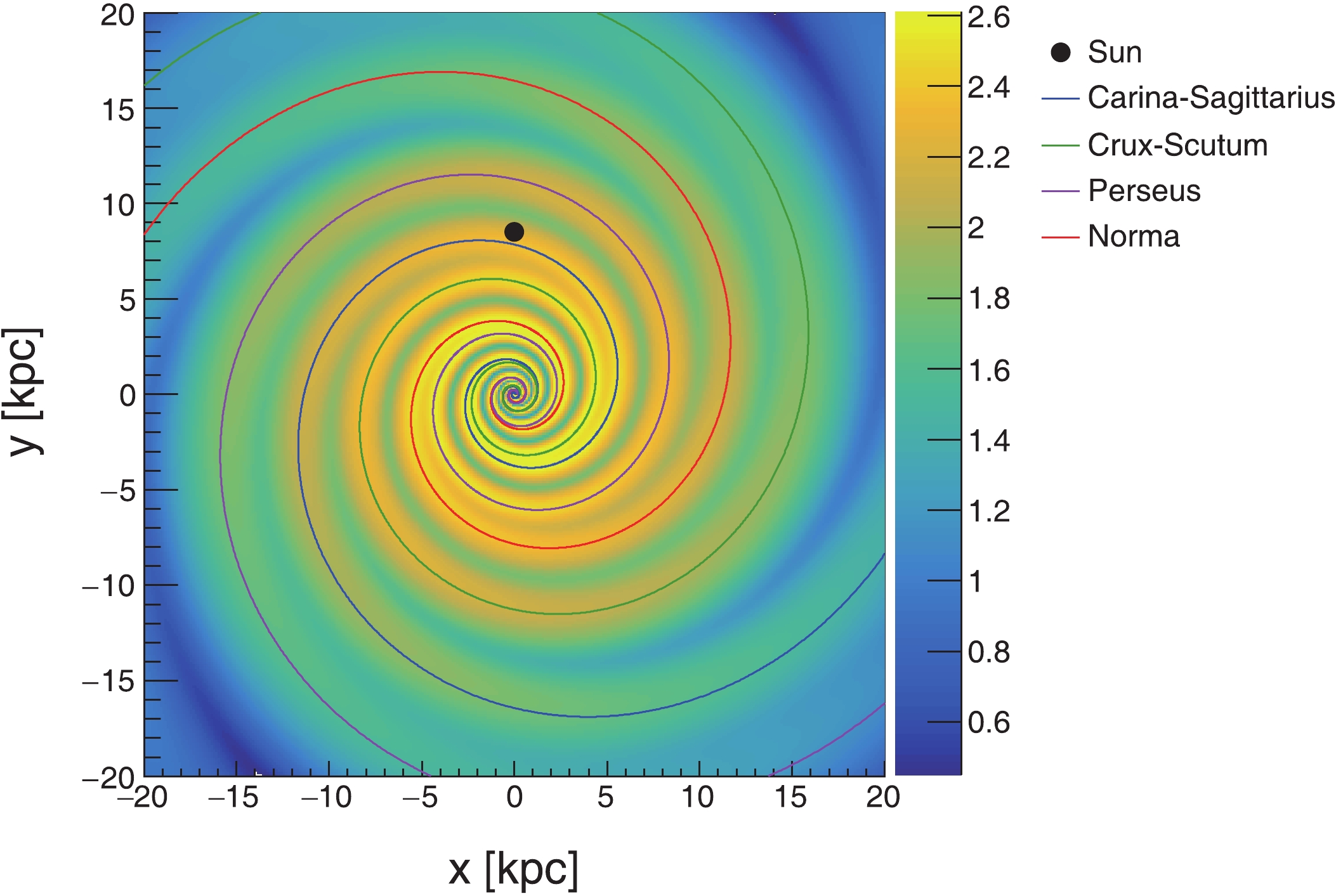 Figure1. (color online) Top view of density distribution of SNRs in the Galaxy. The Galaxy is assumed to have four spiral arms, with the Sun (depicted as a black point) lying bewteen the Garina-Sagittarius and Perseus arms, about 8.5 kpc away from the Galactic center.
Figure1. (color online) Top view of density distribution of SNRs in the Galaxy. The Galaxy is assumed to have four spiral arms, with the Sun (depicted as a black point) lying bewteen the Garina-Sagittarius and Perseus arms, about 8.5 kpc away from the Galactic center.2
2.3.Local source
Due to the energy loss during the propagation, the characteristic lifetime of energetic electrons and positrons at energy E is less than $\frac{{\partial \varphi }}{{\partial t}} - \nabla ({D_{xx}}\nabla \varphi ) + \frac{\partial }{{\partial E}}(\dot E\varphi ) = Q(E,t)\delta ({{r}} - {{{r}}^\prime })\;.$  | (15) |
$Q(E,t) = {Q_0}(t){\left( {\frac{{\cal R}}{{1\;{\rm{GV}}}}} \right)^{ - \gamma }}\exp \left[ { - \frac{{\cal R}}{{{\cal R}_{\rm{c}}^{{{\rm{e}}_ \pm }}}}} \right]\;,$  | (16) |
${Q_0}(t) = \frac{{{q_0}}}{{{{[1 + (t - {t_i})/{\tau _0}]}^2}}}\;,$  | (17) |
$\varphi ({{r}},E,t) = \int_{{t_i}}^t G ({{r}} - {{{r}}^\prime },t - {t^\prime },E){Q_0}({t^\prime }){\rm{d}}{t^\prime }\;.$  | (18) |
In this section, first of all, the transport parameters of four models are fixed by fitting the B/C ratio and proton spectrum. Then, the energy spectra of electrons and positrons obtained by four models are compared by fixed transport parameters. Finally, the anisotropies of all-electrons are calculated.
2
3.1.B/C ratio and proton spectrum
The benchmark values of the transport parameters for the four propagation models are fixed to explain the B/C ratio, as illustrated in Fig. 2. The orange, green, blue, and black solid lines represent HD + axis, HDB + axis, SDP + axis, and SDP + spiral, respectively. The corresponding transport parameters are listed in Table 2. Compared with the HD picture, both SDP scenarios favor a larger Figure2. (color online) Fit of the B/C ratio obtained by three propagation models, HD + axis (orange), SDP + axis (blue), and SDP + spiral (black). The data are taken from the AMS-02 experiment [72]. In this work, the benchmark values of the transport parameters for these propagation models are fixed by fitting the B/C ratio and proton spectrum.
Figure2. (color online) Fit of the B/C ratio obtained by three propagation models, HD + axis (orange), SDP + axis (blue), and SDP + spiral (black). The data are taken from the AMS-02 experiment [72]. In this work, the benchmark values of the transport parameters for these propagation models are fixed by fitting the B/C ratio and proton spectrum.| Parameters | HD + axis | HDB + axis | SDP + axis | SDP + spiral |
    | 4.3 | 4.3 | 4.6 | 9.65 |
  | 0.45 | 0.45 | 0.6 | 0.65 |
  | 5 | 5 | 5 | 5 |
  | 0.141 | 0.24 | ||
  | 0.1 | 0.12 | ||
  | 30 | 30 | 6 | 6 |
  | 0.045 | 0.0435 | 0.0436 | 0.0436 |
  | 1.8 | 2.03 | 2.0 | 2.0 |
  | 9.9 | 11.0 | 5.5 | 5.5 |
  | 2.35 | 2.35 | 2.40 | 2.3 |
  | 750 | |||
  | 2.11 | |||
  | 500 | 800 | 800 | 800 |
  | 145 | 86 | 82 | |
| a | 0.0815 | 0.079 | 0.0568 | 0.0580 |
  | 1.8 | 2.03 | 2.0 | 2.0 |
  | 9.9 | 11.0 | 5.5 | 5.5 |
  | 2.35 | 2.43 | 2.51 | 2.41 |
  | 370 | |||
  | 2.19 | |||
  | 250 | 250 | 500 | 650 |
? The normalization is set at kinetic energy per nucleon   | ||||
Table2.Parameters of the injection spectrum of the proton, helium, and propagation for HD + axis, HDB + axis, SDP + axis, and SDP + spiral models. For the HD and HDB models, the free propagation parameters are
Notably, the SDP scenarios predict a flattening of the B/C ratio above 1 TeV. Compared with primaries, the hardening of secondaries principally has two sources: the hardening of the propagated primary spectrum and spatial-dependent propagation. Therefore, the propagated secondary spectrum is harder than the primary spectrum, which was substantiated by AMS-02 observations of secondary nuclei [73]. Therefore, an excess in the secondary-to-primary ratios is naturally generated under the SDP model [24, 27, 29]. Future precise measurements of the B/C ratio above TeV could verify this observation.
Figure 3 shows the propagated proton spectra obtained by four different propagation models. The red squares, gray inverted triangles, black crosses, and violet circles represent AMS-02, CREAM, DAMPE, and CALET measurements, respectively. The parameters of the proton injection spectrum are listed in Table 2. The HD model predicts that the propagated spectrum drops as a featureless power-law starting from tens of GeV (depicted by the orange line). This is visibly different from current observations. Compared with that in the HD model, the propagated proton spectrum under the HDB + axis assumption (shown as green line) is in good agreement with observations, where the spectral index changes
 Figure3. (color online) Corresponding propagated proton and helium spectra. The experimental data are taken from AMS-02 [72, 74] (red square), CREAM [75] (grey inverted triangle), DAMPE [76] (black cross), and CALET [77] (violet solid circles).
Figure3. (color online) Corresponding propagated proton and helium spectra. The experimental data are taken from AMS-02 [72, 74] (red square), CREAM [75] (grey inverted triangle), DAMPE [76] (black cross), and CALET [77] (violet solid circles).In addition, the predicted helium spectra are shown at the bottom of Fig. 3 as well. Table 2 displays the parameters of the injection spectrum of helium by four theoretical models. Observationally, the fitted injection spectrum of helium is 0.08 harder than proton in HDB, while it is 0.11 in the framework of SDP models. This may originate from the acceleration process at source region. To reproduce the flattening of proton and helium spectra above ~ 200 GeV, in the HDB model the spectral break of injection for proton and helium is tuned at rigidity
It is worth to further evaluate the total energy of CRs injected by a single SNR in the SDP model, according to the normalization
2
3.2.Electron and positron spectra
Figure 4 demonstrates the calculated positron spectra obtained by different propagation models: HD + axis (upper left), HDB + axis (upper right), SDP + axis (lower left) and SDP + spiral (lower right). The blue and green lines are the components contributed by the background and local sources, respectively, where the background positron fluxes before and after rescaling are shown as blue dashed and solid lines, respectively. The black line is the sum of rescaled background and local fluxes. Table 3 lists the distance and age of local sources as well as the parameters for the injection spectrum of background and local sources.| Parameters | HD + axis | HDB + axis | SDP + axis | SDP + spiral |
  | 0.16 | 0.16 | 0.30 | 0.30 |
  | 1.7 | 1.69 | 1.53 | 1.14 |
  | 2.8 | 2.81 | 2.9 | 2.72 |
  | 4 | 4 | 5.1 | 5.1 |
  | 2.0 | 1.8 | 1.4 | 1.0 |
| r/kpc | 0.35 | 0.25 | 0.2 | 0.25 |
| t/yr |   |   |   |   |
  |   |   |   |   |
  | 1.94 | 2.012 | 2.46 | 2.40 |
  | 8 | 8 | 8 | 8 |
  | 1400 | 1420 | 650 | 580 |
  | 1210 | 1210 | 660 | 620 |
? The normalization is set at kinetic energy   | ||||
Table3.Parameters of injection spectra of background electrons and local electron-positron pairs under HD + axis, HDB + axis, SDP + axis, and SDP + spiral models. The parameters of background electrons contain normalization factor
 Figure4. (color online) Positron spectra computed by four propagation models, i.e., HD + axis (upper left), HDB + axis (upper right), SDP + axis (lower left), SDP + spiral (lower right). To consider the uncertainties from p-p collision cross-sections, propagation, etc., the secondary positrons obtaineed by HD + axis, HDB + axis, and SDP + axis models are multiplied by a scale factor
Figure4. (color online) Positron spectra computed by four propagation models, i.e., HD + axis (upper left), HDB + axis (upper right), SDP + axis (lower left), SDP + spiral (lower right). To consider the uncertainties from p-p collision cross-sections, propagation, etc., the secondary positrons obtaineed by HD + axis, HDB + axis, and SDP + axis models are multiplied by a scale factor In the HD model, the scale factor
In all four models, the injection spectrum of the local source is harder than that of background. However, in the HD and HDB models, the difference between both is larger. The power index of local source is around 2.00, while it is 2.8 for the background SNRs. However, in the SDP models, the obtained power index of local pulsar increases and their difference becomes smaller. Moreover, it is noteworthy that in the HD models, the propagated positron spectrum shows a pronounced high-energy tail, which is obviously different from the high-energy sharp fall-off under the assumption of a transient injection [15]. This is due to the continuous injection process of pulsar [65, 78]. Likewise, a similar phenomenon is also visible in the corresponding electron spectra, as shown in Fig. 5. However, this feature disappears in the SDP models. Instead, the energy spectra above TeV energies slowly decline. As the diffusion process is significantly slower in the vicinity of the Galactic disk, the energetic electrons from the local source suffer more energy loss such that most of them were exhausted before arriving at the solar system. To fit the high-energy drop, the cutoff rigidity of the local injection electron/positron spectrum is 8 TV.
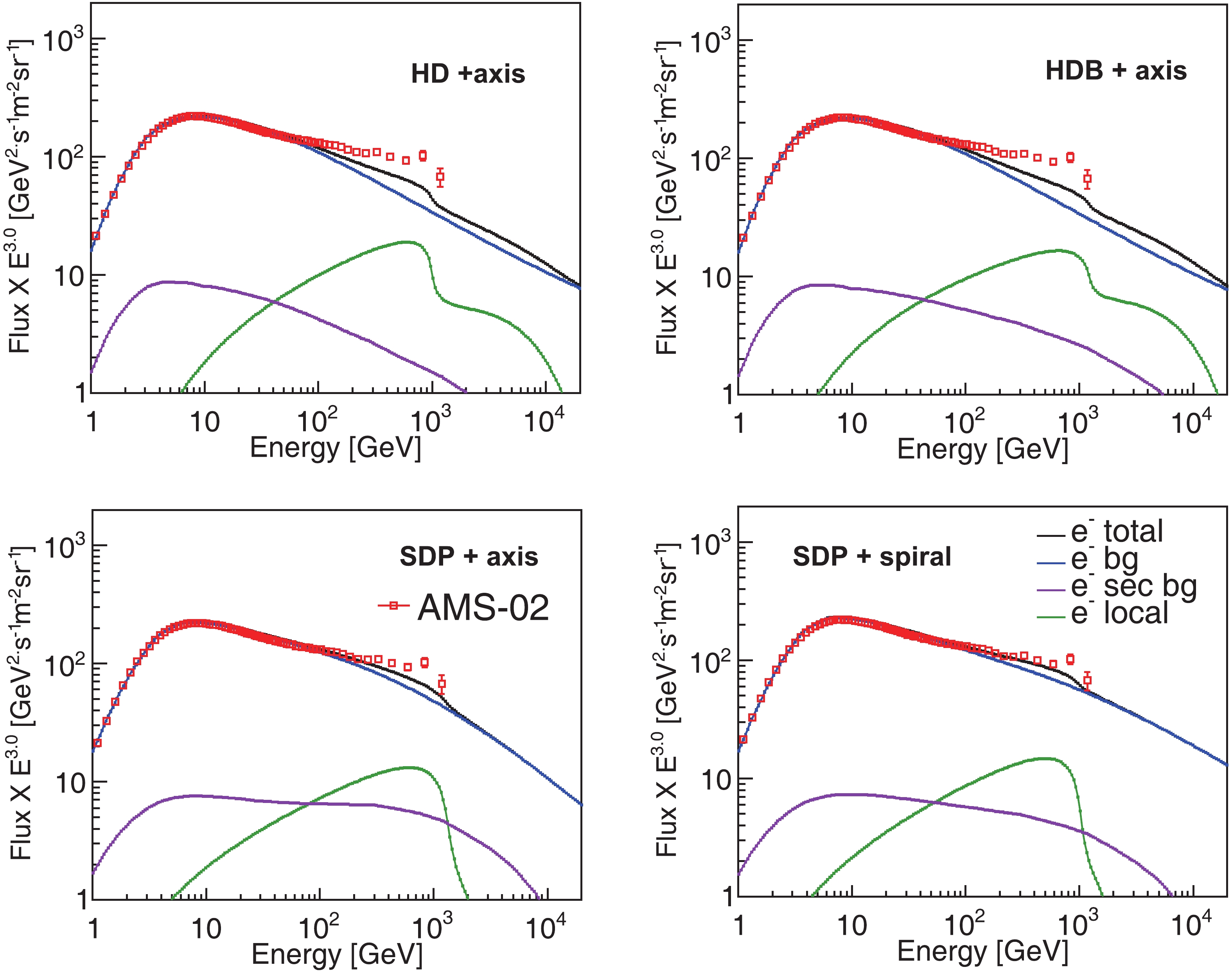 Figure5. (color online) Electron spectra computed by four transport models, HD + axis (upper left), HDB + axis (upper right), SDP + axis (lower left), and SDP + spiral (lower right). The red squares depict the measurements from the AMS-02 experiment [7]. The blue and violet lines represent the background primary and secondary electron fluxes, respectively, while the green line refers to the electron flux from the local source.
Figure5. (color online) Electron spectra computed by four transport models, HD + axis (upper left), HDB + axis (upper right), SDP + axis (lower left), and SDP + spiral (lower right). The red squares depict the measurements from the AMS-02 experiment [7]. The blue and violet lines represent the background primary and secondary electron fluxes, respectively, while the green line refers to the electron flux from the local source.The observations confirm that there is a hardening above ~40 GeV in the electron spectrum, which indicates a primary component. Under the model of a local pulsar, the contribution of electrons from the local source is determined by the positron data. Above ~100 GeV, the electron data could not be described both in the HD model, even with a local source. This is due to the excess of primary electron flux. In the observed electron flux, this contains both primary and secondary components, despite the latter being far smaller than the former. In contrast, in either the propagation process or the local pulsar, almost the same amount of electrons and positrons are generated. Thereupon, the difference between electrons and positrons is expected to be within the primary components, and this is described by a single power-law spectrum in the conventional diffusion model. However, the analysis of [5] revealed that there is also a significant excess in this component. One of the origins for the extra electrons is the local SNRs. In a recent work by [15], to efficiently describe both electron and positron spectra, a nearby supernova remnant surrounding by a giant molecular cloud is introduced, where the additional electron-positron pairs, apart from the primary electrons, are produced inside the SNR through interactions between CRs and the molecular clouds. For the HDB model, its flux of propagated secondary electrons is enhanced slightly, which is attributed to the hardening of the proton spectrum. In comparison with the primary component, this contribution of secondary electrons is small. Likewise, it is evident that above ~ 100 GeV, the electron spectrum of the HDB model could not reproduce the AMS-02 observations. In the SDP model, the calculated electron flux is flatter, such that the background electrons significantly augment at high energy, as shown in Fig. 5. The overabundant primary electrons are attributed to the effect of SDP. Hence, the observed electron spectrum could be better described by the SDP model. Further, the modulation potential
The electron and positron spectra are added for further comparison with the observed all-electron spectrum, which is shown in Fig. 6. The experimental data of AMS-02, CALET, DAMPE, and H.E.S.S are represented by red squares, violet circles, black crosses, and green inverted triangles, respectively. From ~50 GeV to ~1 TeV, the DAMPE experiment apparently disagrees with AMS-02 and CALET. Furthermore, the H.E.S.S experiment extended its measurement of the all-electron spectrum up to 20 TeV, and the data is in a good agreement with both AMS-02 and CALET at around TeV energies. Therefore, we do not fit the DAMPE data in this work. We compare the calculated all-electron spectra of the four models with the observations of AMS-02, CALET, and H.E.S.S experiments. The all-electron spectra is well reproduced by the SDP + spiral distribution scenario within the entire energy range. The break around TeV is due to the local source, while the power-law drop above that energy arises from the background components.
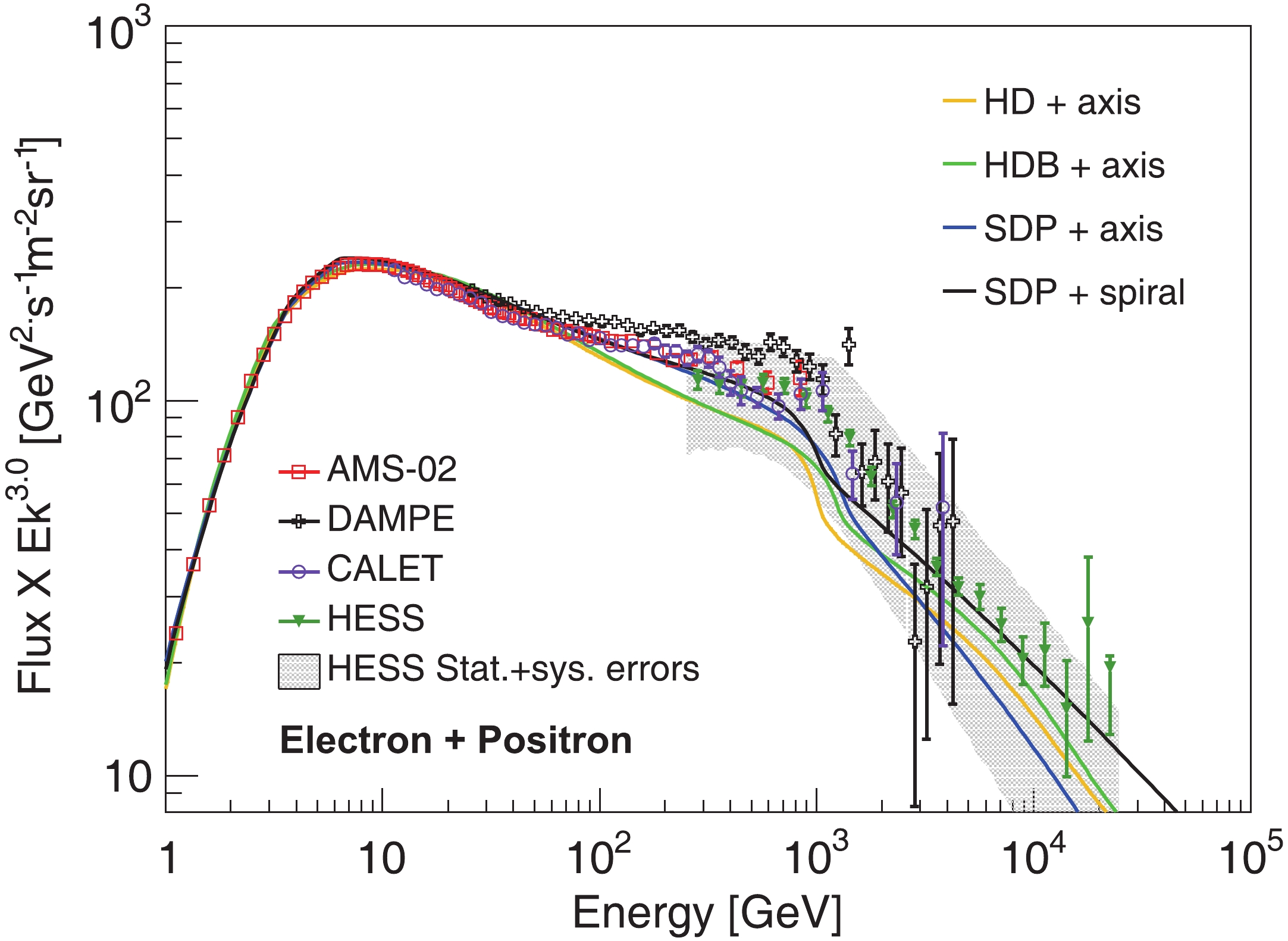 Figure6. (color online) All-electron (electron + positron) spectra calculated by four models. The red squares, violet circles and green inverted triangles depict the data of AMS-02 [7], CALET [79], and HESS [9], respectively. The black crosses correspond to the measurements of the DAMPE experiment [6].
Figure6. (color online) All-electron (electron + positron) spectra calculated by four models. The red squares, violet circles and green inverted triangles depict the data of AMS-02 [7], CALET [79], and HESS [9], respectively. The black crosses correspond to the measurements of the DAMPE experiment [6].2
3.3.All-electron anisotropy
The electrons and positrons above TeV mainly originate from the local sources within 1 kpc around the solar system. Similar to CR nuclei [80, 81], the local source may also leave an imprint on the all-electron anisotropy as well as the energy spectra. The dipole anisotropy is defined as $\delta = \frac{{{\psi _{{\rm{max}}}} - {\psi _{{\rm{min}}}}}}{{{\psi _{{\rm{max}}}} - {\psi _{{\rm{min}}}}}} = \frac{{3{D_{xx}}}}{v}\frac{{|\nabla \psi |}}{\psi }\;.$  | (19) |
Figure 7 illustrates the energy dependence of the anisotropy of the electron + positron when the local pulsar is along the direction of the Galactic center. The blue solid lines denote the anisotropy from the background, and the green lines show the anisotropy generated by the local pulsar when neglecting the background anisotropy. The black lines depict sum of the background and local anisotropies. In the HD and HDB models, the local source dominates the anisotropy, and the total anisotropy is very large, which is close to the observational upper limits. This is caused by the larger diffusion coefficient nearby the solar system. However, in the SDP models around the Galactic disk, the diffusion coefficient is significantly smaller. Therefore, contrary to the HD and HDB models, the SDP models predict a very small background anisotropy. Even when taking the local source into account, the total anisotropy is still well below the current upper limits, compared with the conventional propagation models [78].
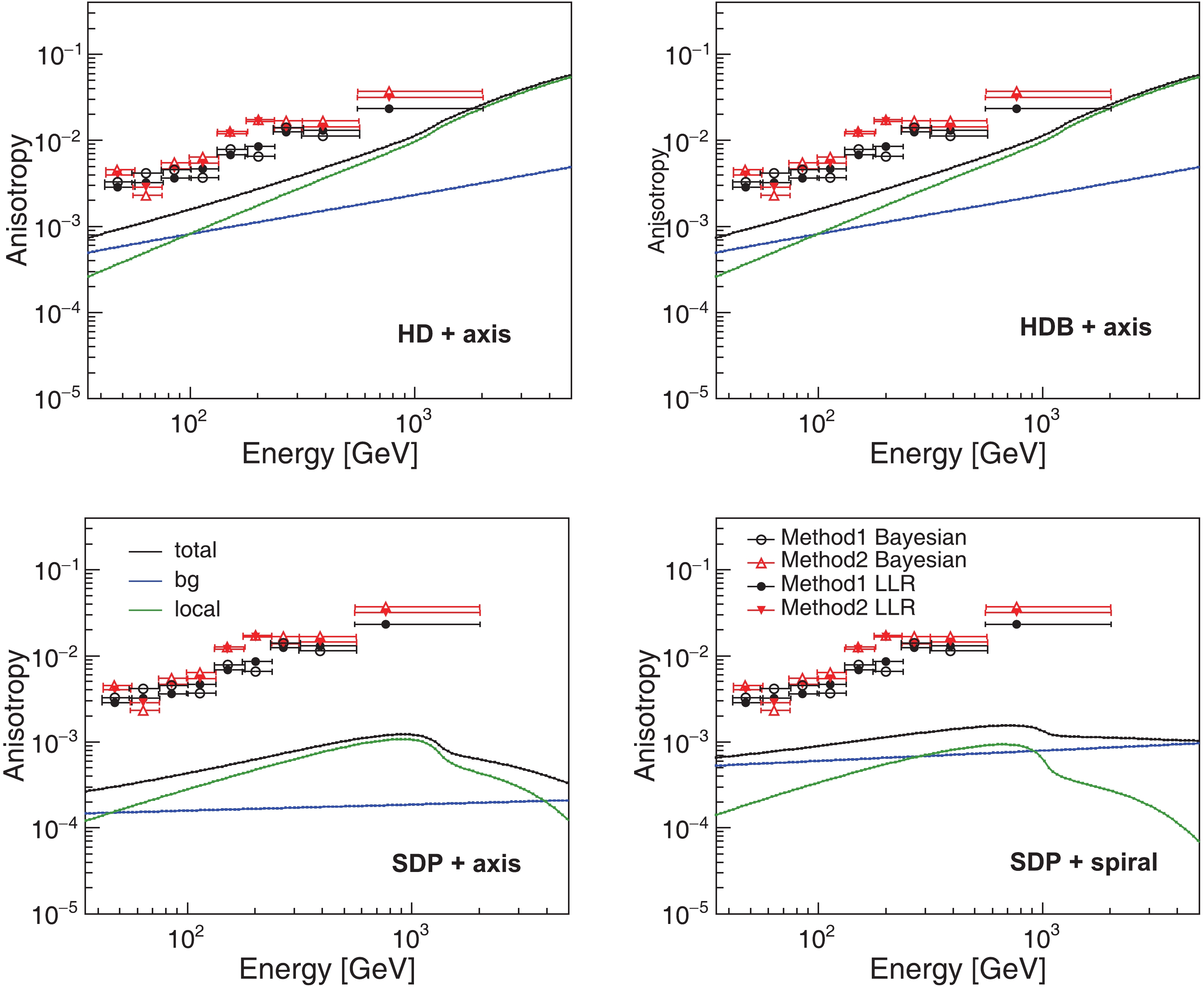 Figure7. (color online) Anisotropies of the electron with the local source along the direction of Galactic center obtained by the models HD + axis (upper left), HDB + axis (upper right), SDP + axis (lower left), and SDP + spiral (lower right). The blue, green, and black solid lines represent the anisotropies of background, local source, and their sum, respectively. Both black and red markers are the upper limits set by the Fermi-LAT experiment [82].
Figure7. (color online) Anisotropies of the electron with the local source along the direction of Galactic center obtained by the models HD + axis (upper left), HDB + axis (upper right), SDP + axis (lower left), and SDP + spiral (lower right). The blue, green, and black solid lines represent the anisotropies of background, local source, and their sum, respectively. Both black and red markers are the upper limits set by the Fermi-LAT experiment [82].Fig. 8 illustrates the same electron anisotropies, but with the local pulsar in the direction of anti-Galactic center. The CR streaming from the local pulsar opposes that of the background, which could further lower the total anisotropy. When the CR streaming from local pulsar is comparable to that of background, the total anisotropy reaches a minimum. In the HD and HDB models, from tens of GeV to ~1 TeV, the local source consistently dominates, except for the lower energy, where the background streaming takes effect. A similar case occurs in the SDP + axis distribution. However, for the SDP + spiral distribution model, the background and local streaming are comparable at ~100 GeV and ~2 TeV, respectively, and there are two minimums in the total anisotropy. Within this energy range, the anisotropy is dominated by the local pulsar, while background sources play a major part at the remaining energies.
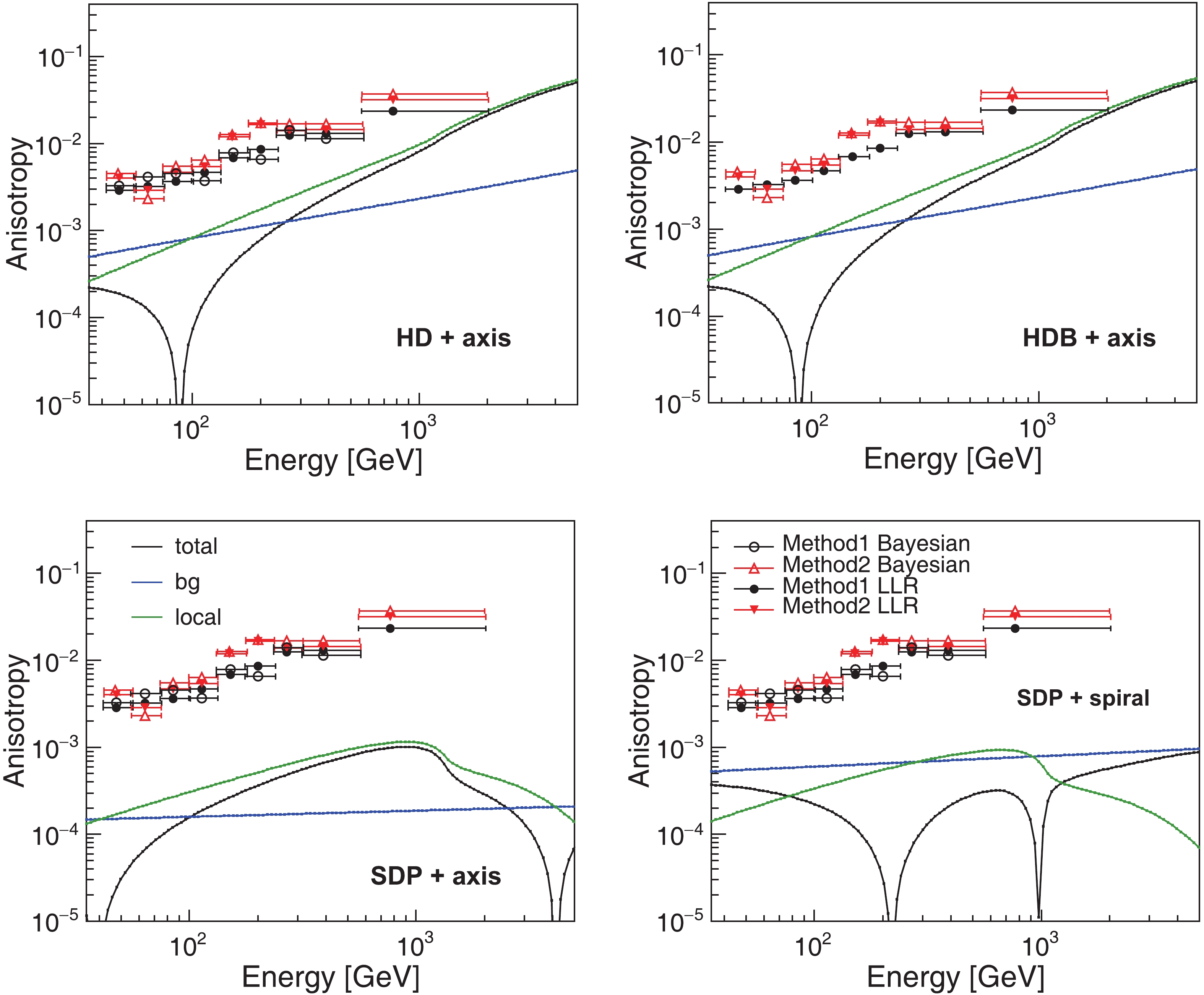 Figure8. (color online) Anisotropies of the electron with the local source in the direction of anit-Galactic center.
Figure8. (color online) Anisotropies of the electron with the local source in the direction of anit-Galactic center.In the local source model, both the distance and age are evaluated by fitting the AMS-02 observations. The local pulsar, e.g., with
The anisotropy of the electron is calculated by four models. In the conventional model, the total anisotropy is dominated by the local source, and it is very close to the upper limits set by the Fermi-LAT experiment due to the larger diffusion coefficient. However, in the SDP model, owing to the smaller diffusion coefficient around the Galactic disk, the level of the background anisotropy is significantly lower. In this case, even including a local source, the total anisotropy remains considerably small. The precise future measurements of electron anisotropy by the DAMPE, LHAASO [84], and HERD [85] experiments could test our model.
DRAGON [53] is available at https://github.com/cosmicrays
